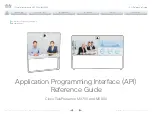
D15335.08 Cisco TelePresence MX700 and MX800 API Reference Guide CE9.2, NOVEMBER 2017.
Copyright © 2017 Cisco Systems, Inc. All rights reserved.
5
Cisco TelePresence MX700 and MX800
API Reference Guide
New features and improvements
Macro framework
The macro framework allows users and integrators to write
JavaScript macros in order to automate scenarios and
customize endpoint behavior so that it suites an individual
customer’s requirements.
The combination of macros and powerful features such as
listening for events/status changes, automating execution of
commands and configurations, and providing local control
functionality for the In-Room control feature, provides many
possibilities for custom setups.
Minor behavioral changes, such as having the video system
in Do Not Disturb for an infinite amount of time, can be
easily realized by macros. Some other examples are: Reset
configurations automatically, make a call at a certain time
of the day, and issue alert or help messages depending on
status changes.
The macro editor, which also provides several example
macros, is available from the video system’s web interface.
Branding and halfwake customization
You can upload your own text and images to customize the
appearance of the screen and user interface in both the
halfwake state and the awake state.
In the
Halfwake
state you can:
• Add a background brand image to the screen and user
interface.
• Add a small logo in the bottom right corner of the screen
and user interface.
In the
Awake
state you can:
• Add a small logo in the bottom right corner of the screen
and user interface.
• Add a label or message in the bottom left corner of the
screen (not the user interface).
Source composition
You can compose up to four input sources (depending on
how many input sources are available on the codec) into one
image. This is the image that will be sent in the main video
stream to the far end in a call. Source composition can only
be enabled via the API, so we recommend creating a user
interface extension combined with a macro to control the
compositions on demand.
This feature replaces some of the functionality that was
provided by the TC Console application for TC software.
HTTP Proxy support
You can set up the video system to go through a HTTP Proxy
when registering it to Cisco’s cloud service, Cisco Spark.
User interface features
• The Settings panel is restructured.
• The Settings panel in the user interface (Touch 10) can
be protected by the video system’s admin password. If
the password is blank, anyone can access the Settings
and factory reset the system.
• If you select the Russian language on the user interface,
you can choose between a Russian keyboard and a
keyboard with a Latin character set.
• Arabic and Hebrew languages are added to the user
interface. Also localized keyboards are included.
• Basic IEEE 802.1x settings are added to the Settings
panel in the user interface.
Support for the Snap to Whiteboard feature
The Snap to Whiteboard feature is now available for all
products that have a camera with speaker track functionality:
SX80 with Cisco TelePresence Speaker Track 60 camera or
Cisco Spark Quad camera, MX700/MX800 with dual camera,
Room Kit, Room Kit Plus, Room 55 and Room 70.
When the video system detects a person that is speaking
close to the whiteboard, the camera view will switch to the
whiteboard area. The wizard in the Settings panel on the
Touch 10 user interface helps you to set up the feature and
define where the whiteboard area is.
What’s new in CE9.2
This section provides an overview of the new and
changed system settings, and the new features and
improvements in the Cisco Collaboration Endpoint
software version 9.2 (CE9.2) compared to CE9.1.
For more details, we recommend reading the Software
release notes:
http://www.cisco.com/c/en/us/support/collabo-
ration-endpoints/telepresence-quick-set-series/
products-release-notes-list.html
Introduction
About the API
xConfiguration
Appendices
xCommand
xStatus
Introduction






































